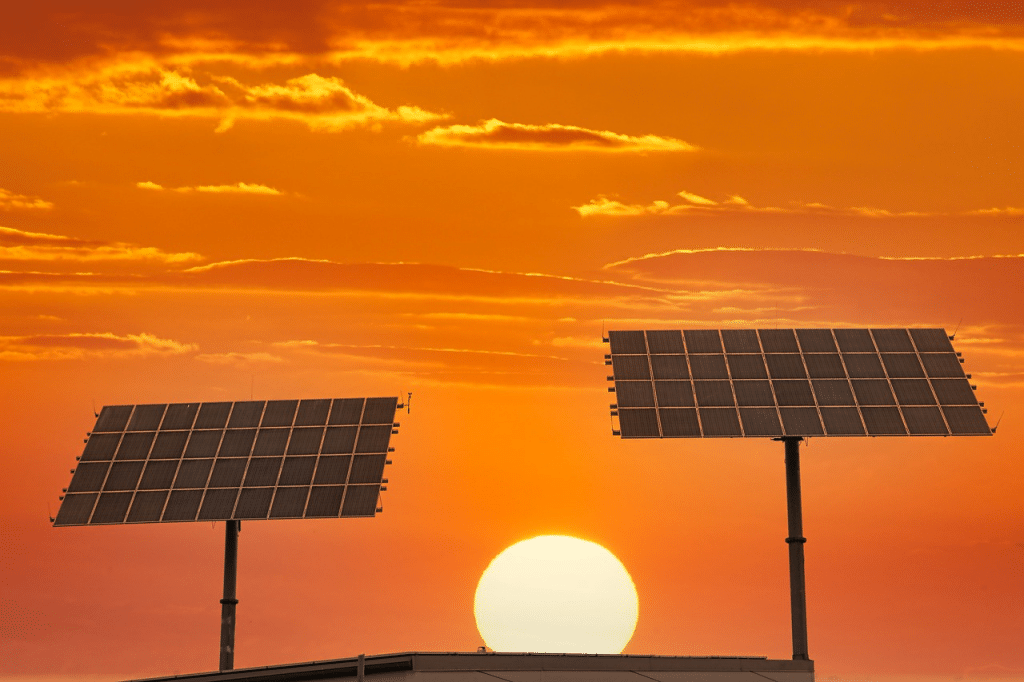Table of Contents
ToggleIn Australia, solar energy is undergoing a massive transformation as it is gradually moving to a phase where massive solar farms are up and running. The climate of Australia offers extremely high potential for solar energy harvesting in the form of intense sunshine and vast resources.
The graph below shows the total capacity of small scale solar PV installation from 2010 to 2019.
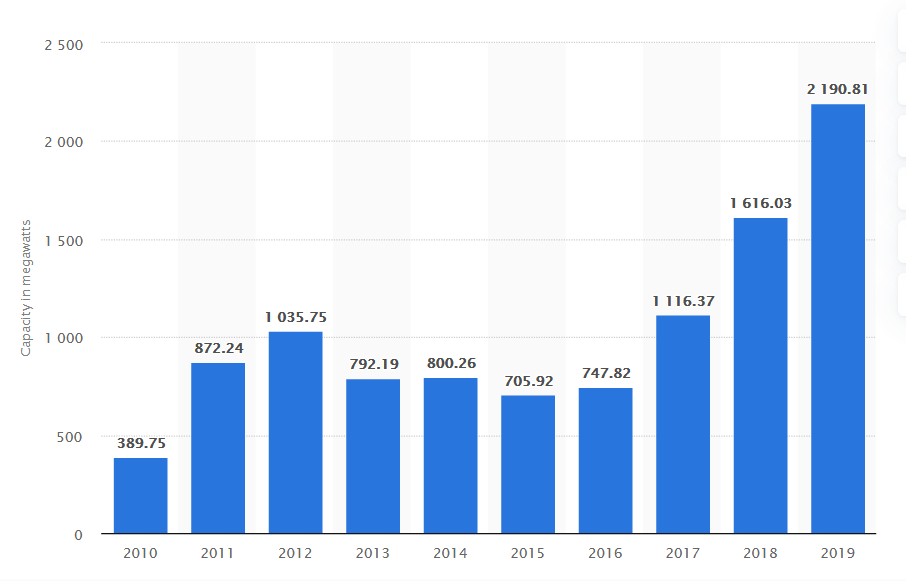

Source: Statista
In the country, a record of 1.96 million residential rooftop solar systems and 78,000 commercial and industrial rooftop solar systems already existed by the end of the year 2018, which amounts to a total of 2.04 million rooftop solar PV systems.
It is such great news that as early as in 2018, over 200,000 solar PV systems were installed. The country of Australia ranks top in residential uptake of solar power.
The national average of free-standing households with an active solar PV system is 20%. By 2020 Australia has over 10.7 GW of rooftop solar in 2.4 million systems.
Solar power in Australia- statistics
Statistics show that solar power usage in Australia is growing at an immense rate.
As of June 2020, Australia has over 2.4 million solar PV installations with a combined capacity of 18,583 MW.
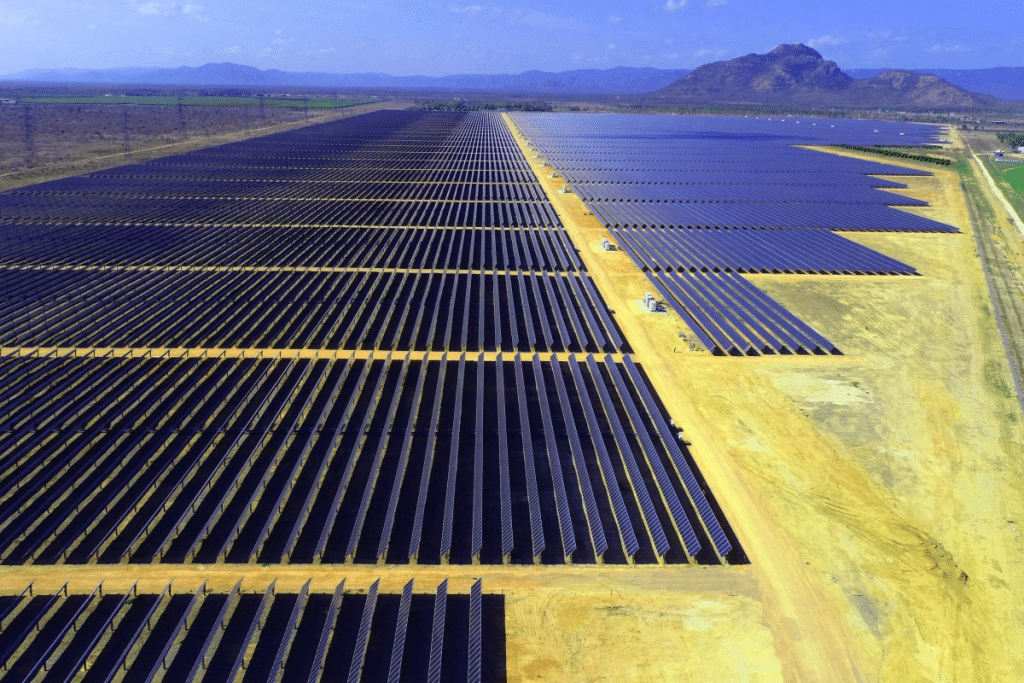

Source: South China Morning Post
Australia is among the top ten solar companies in the world by rank and capacity. The country has an installed PV capacity of 12,959 MW by June 2019.
As per the 2019 Energy Transition Index by the World Economic Forum, the country ranked 43rd in the list of 115 countries. This report primarily focussed on the rates at which the energy performance of the countries improve and their readiness to embrace sustainable energy.


Source:assets.clean energy council
The 2018 report indicated that one in every five houses in Australia have solar power to cut down the cost of electricity. If this rate continues at a steady pace, soon by 2025, the country will reach 50% renewable capacity.
Studies done by the Australian Energy Market Operator indicated that rooftop solar would produce 85% more power than the 2017-18 financial year.
Another report by Green Energy Markets stated that in the first three months of 2019, a record number of rooftop solar panels had been installed in commercial and residential buildings.
This is an increase of 46% during the same period the previous year. At the beginning of 2019, 87 large-scale renewable energy projects are underway, and high utility batteries are installed all over the country.
Studies have shown that customers will save nearly $600 million on their electricity bills over the next twelve-year.
What are solar farms?
These are large scale solar installations which are used to collect the energy of the sun.
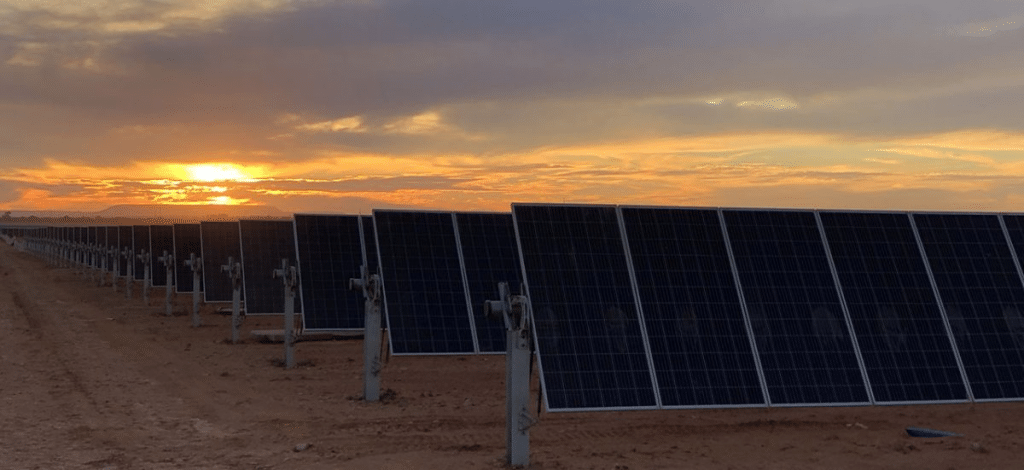

Source: PV Magazine
The most common methods are mainly by using PV(Photovoltaic) panels or using a similar method. A solar farm or sometimes referred to as a photovoltaic power station is a large decentralized array of solar panels providing electricity to the power grid.
From the perspective of a broader definition, solar farms could also include other ground-mounted arrays of solar panels capable of generating power for many households.
This concept of a solar farm can be associated with a utility-scale solar or community solar.
Are you wondering how a solar farm is different from commercial solar power systems or rooftop solar?
Solar farms operate as power plants, similar to that of a hydroelectric power plant or natural gas power plant to generate electric power for the consumers. But the extent of power produced may vary depending on the number of panels used.
A solar farm feeds energy into the electricity grid just like a fossil or nuclear power plant does, except that there is no pollution of any kind and uses very little water.
In a solar farm, solar panels are installed on short towers over an area as huge as 100 acres. Although most of the existing solar farms are owned and operated by independent power producers, the number of projects owned by communities is also increasing.
The present-day solar technology requires approximately 2.5 acres of solar panels in high-intensity sun areas to produce a megawatt of electric power.
The space requirement is five acres in moderate sun locations. A megawatt or one million watts of energy is sufficient to power 650 residential homes for a day.
Key solar companies in Australia
1. Tindo solar
This company was established in 2011. Tindo solar is the manufacturer and designer of high-quality solar panels in Australia. The company supplies solar products all over the world.
The company has a state-of-the-art 60 MW capacity production unit in Adelaide, South Australia. The prime focus of the company is to increase solar panel productivity and create jobs in Australia, especially in the area of the advanced manufacturing sector.
The word “Tindo” is coined from the Kaurna Warra aboriginal language, which means sun.
The company’s most popular product is Tindo Karra 300W PERC monocrystalline solar panel, designed and produced with the help of Australian National University in Canberra.
The product has been in production for almost eight years now, and interestingly the failure rate of this product is 200 times lesser than its competitors. Tindo Karra 300 provides a minimum of 25 years of long-term high performance.
2. Trina solar
This company is one of the first PV enterprises from China to become a world leader in the manufacturing of solar PV systems. Ever since the company was established in 1997, it made a significant impact on the manufacture of solar PV systems in the land of Australia.
The company manufactures state of the art products and provides services to promote the development of sustainable energy. In 2018, the company delivered 40GW solar modules all over the world earning 17th spot on “2018 Global Top 500 New Energy Enterprises.”
3. Risen Australia
The company started making its presence in the Australian market as early as in 2008, by supplying solar-based products in the Australian market.
Currently, the company is one of the prominent China-based PV solutions providers in the country. The company has rightfully earned its position as the sixth-largest PV module supplier in the world with more than 10,000 working all over the globe.
Risen Energy Australia currently ranks the third position in the rooftop PV distribution segment in Australia. This accounts for nearly 10% of the country’s total rooftop market. It is also planning to invest in 2 GW of renewable energy projects in Australia.
The company had sold 120 MW of rooftop panels during 2018-19, which translates into the highest spike in sales in one year.
4. Australian Solar Manufacturing Pty Ltd
This company is a Proprietary Limited Company that was founded and registered in early 2009. ASM is located in Hallam, Victoria and is a fully Australian-owned and managed company.
Its premium product is ASM 200M Monocrystalline solar module product line, which has an efficiency of 18.86% for the cell and 15.88% for the module.
Other variants include ASM 170M, ASM 175M, ASM 180M, ASM 185M, ASM 190M, and ASM 195M. The company also produces a solar mounting system, solar connectors & cables, solar DC isolator, solar PV arc detection unit, and others.
All of their solar modules have a 10-year workmanship guarantee and a 25-year power output warranty.
5. WINAICO Australia Pty Ltd
The company earned a high reputation in the solar industry due to its reliability and performance in the harsh Australian conditions. Winaico’s worldwide headquarters are in Australia, Germany, Taiwan, the US, and Japan.
Their solar panels are the only such products in Australia that come with a 2-year insurance policy that covers all risks. There is a 15-year replacement warranty for the product.
WINAICO Australia produces solar panels with three variances, which are:
- WST-310M6
- WSP-320MX
- WSP-330MX
6. Q CELLS Australia Pty. Ltd
The company is a part of Hanwha Group, which is a global Fortune 500 company founded in 1952 with over more than $55 billion in total revenue. Q CELLS has developed Q.ANTUM Technology to ensure the maximum efficiency of traditional solar modules. This technology ensures high performance even under different weather let it be winter or summer, cloudy or clear skies.
The solar panels produced by this company are specially designed to suit the Australian climate.
The company produces the following solar modules:
- Q.Peak Duo G5 for residential customers
- Q.Peak-G5.1 for commercial and industrial applications
- Q.Plus L-G4.2 for utilities.
7. Suntech
Ever since the company was established in 2008, they have expanded to more than 80 countries in the world. Suntech designs and produces crystalline silicon solar cells and modules and is a globally known solar PV manufacturer in the world.
The prime goal of the company is in research and development on improving the overall efficiency of its solar panels. These efforts have resulted in the development of high-quality, cost-effective and reliable products.
Suntech produces a range of solar modules, which are:
- Standard modules
- Smart modules
- Lightweight modules.
- Half-cell modules
- Bifacial double glass modules
- High power modules
The company has gained an excellent brand reputation in the Australian market and has also successfully passed the verification of the Australian Clean Energy Council (CEC).
Government incentives and subsidies
The great success for solar panel installations in Australia can be attributed to several support schemes by the state and the federal government. Currently, for Australian households, three main support schemes are available. They are from:
- State government
- Federal governments and
- Electricity retailers
An overview of what’s available state-by-state is shown in the chart below:
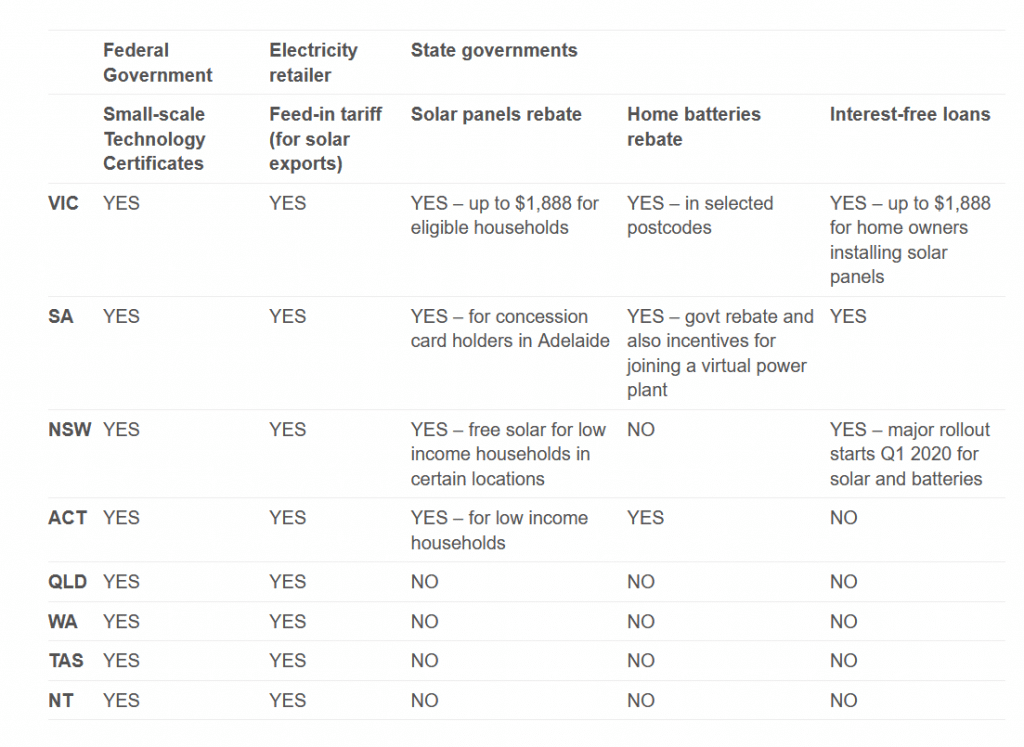

Source: Energy matters
1. Federal
All small businesses and Australian households can get subsidies for solar panels from the federal government, called Small-scale Technology Certificates. The subsidy value depends on the location, but overall it brings a cost reduction of about 30%.
2.State governments
This is highly varied depending on the state where you live. If you live in WA, Queensland, the Northern Territory, state government incentives are not available.
On the other hand, if you are from Victoria, NSW, South Australia or the ACT, there are several state government rebates and incentives for solar and/or home batteries.
Australian Federal Government Solar Incentive
Small-scale Renewable Energy Scheme from the federal government was put in place to achieve the Renewable Energy Target of Australia. This scheme uses a mechanism known as Small-scale Technology Certificates (STCs), which reduce the upfront cost of solar PV installation.
STC can help to reduce the overall cost by 30%. This is available for anyone in Australia for systems up to 100KW.
Few points to consider:
- STCs are available to anyone who is living anywhere in Australia for installations up to 100kW.
- You do not have to apply for Small-scale Technology Certificates. They are typically applied as a point of sale discount by your solar retailer.
- Currently is no upper limit to the number of properties you can get STCs
3. Feed-in tariffs
Several states in Australia have set up schemes to promote the uptake of solar PV generation. The main idea is to promote the selling of electricity generated in the household PV systems to the grid.
In March 2009, the capital territory of Australia started a gross feed-in tariff.
- For PV systems, up to 10 kW, the payment was 50.05 cents /kWh.
- For systems that are from 10 kW to 30 kW, the payment was 40.04 /kWh.
- The payment was revised downward once before an overall capacity was reached and the scheme closed.
- Payments are made every quarter depending on the amount of energy generated.
Final Words
The country of Australia is on a fast track to tap its untapped potential of solar power. With so many companies to roll out the latest and most innovative technology, the country is on a fast pace to growth.
Extensive research done in Australian universities is also helping to bring in smart technology to achieve the full potential of the sun. Along with it, several subsidies provided by the Federal and State government will help to catalyze the current growth.

